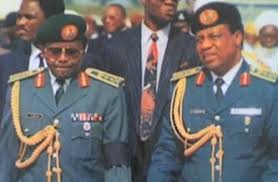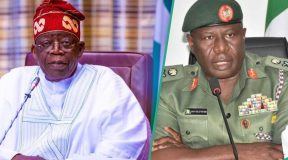Details Of Critical Factors That Engineered The Coup
OpenLife Nigeria reproduces excerpts, dwelling on the critical details of the process that led to the overthrow of General Yakubu Gowon as Head of State and Commander-in-Chief, Armed Forces, Federal Republic of Nigeria in 1975.
The details are contained in a recently launched book by former military President Ibrahim Babangida titled ‘A Journey In Service’
By July 1975, General Yakubu Gowon had been in office for nine long years, the longest continuous period that any other Nigerian had served as head of state.
A pleasant officer and a gentleman who neither smoked nor drank, Gowon’s boyish good looks and genial broad smile endeared him to many Nigerians drawn across ethnic and religious lines.
The fact that he was one of the best-trained of our soldiers earned him the respect of members of the Nigerian armed forces, again, across ranks, service, and discipline.
Directly after graduation from Barewa College and his enlistment in the Nigerian Army, he was trained, first in 1954, at the Royal West African Frontier Force’s (RWAFF’s) Regular Officers
Special Training School at Teshie in Ghana.
Then, between 1955 and 1956, he attended the Royal Military Academy at Sandhurst in the United Kingdom, where his coursemates included Arthur Unegbe and Alex Madiebo.
Before his staff college course in Camberley, United Kingdom, in 1962 and after, Gowon served twice (1960 and 1963) as part of the Nigerian contingent of the United Nations peacekeeping mission to the Congo.
He was appointed as the first Indigenous Adjutant-General of the Nigerian Army after his return from his second Congo posting.
Barely days after returning from A Journey In Service, another staff college course at the Joint Service Staff College in the UK, the Majors struck on January 15, 1966.
And as we all bore witness, seven months after, he emerged, at 32, not just as Nigeria’s head of state on August 1, but as Africa’s youngest head of state at the time.
As head of state, it would be fair to say that he gave the job his best. As I implied in the preceding chapter of this volume, his most enduring legacy is that he successfully prosecuted the Nigerian civil war, which consolidated the territorial integrity of Nigeria and its unity, thus reducing the possibility of secession.
His famous ‘No victor, no vanquished’ speech at the end of the civil war, followed by an amnesty for a majority of those who fought on the Biafran side under a comprehensive Reconciliation, Reconstruction, and Rehabilitation policy, was an unprecedented gesture of goodwill in a post-civil war situation.
But Gowon did a lot more. As I said in the previous chapter, he created 12 new states and promised to create more. He started the National Youth Service Corps Scheme (NYSC), designed to foster
national unity by requiring Nigerian graduates to complete a one year national service programme in parts of the country different from their own.
In the face of the meteoric upturn in the economy, fuelled by unprecedented revenue from oil, national economic activity grew at an astronomical rate.
Long before it became a popular parlance, Gowon was the original Mr Infrastructure! New road networks were constructed across the country’s length and breadth, and new bridges and air terminals sprang up in major cities.
While still reeling from the dizzying heights of the oil boom, the Indigenisation Decree of 1972, which declared many sectors of the economy off-limits to all foreign investment, was enacted while retaining only minority participation for foreigners in other areas.
Although the Decree provided windfall gains for many well-connected Nigerians at the time, it proved, many argued, detrimental to the non-oil sector of the economy.
Then, for reasons attributable, presumably, to the extended stay in office, the administration started to face problems connected with accusations of corruption, not necessarily by the head of state but by some of his appointees, among them Joseph Tarka and the Governor of the Benue-Plateau State, Joseph Gomwalk.
However, the direct motivation for overthrowing the government came from the unhappiness of junior officers in the administration over the change of date of the return to civil rule. In his October 1
broadcast to the nation in 1974, Gowon announced that his promise made in 1970 to return the country to a democratic government was no longer realistic.
Ironically, General Gowon’s reasons for continuing in office, what he described as a ‘high degree of sectional politicking, intemperate utterances and writings,’ designed ‘to whip up ill feelings within the
country for the benefit of a few,’ had, as would be seen in subsequent sections of this volume, echoes of what I faced almost nineteen years after to the day! Looking back now, Gowon’s fears that it would not take politicians long ‘to return to the old cut-throat politics that once led the nation into a serious crisis’ was the same dilemma I faced as President.
In fairness, well before the October 1, 1974 announcement, General Gowon invited senior military officers from the rank of colonel upwards to deliberate on this subject in early September.
At that meeting, which I recall went on for a while, opinion was split.
Some officers believed that the administration’s earlier promise of a handover date of 1976 to a democratic government should, on principle, be retained.
Others supported the extension of the date of return to civil rule indefinitely to ensure the establishment of more enduring political stability in the country.
Some officers in this category probably felt they had not been compensated enough, presumably with ‘political’ appointments for their sacrifices during the civil war or for sustaining Gowon in power. An extension of military rule would, of course, be of benefit to them.
On the periphery of this group were military officers and top civil servants alike who were convinced that the viable way forward was for General Gowon to transform himself from a military head of state to a civilian executive President since the call by former President Nnamdi Azikiwe and others for a form of diarchy, where the military and politicians would share power, was beginning to gain traction.
Some other officers expressed their displeasure at the ostentatious lifestyle of some of the military state governors and wanted them redeployed in the event of an extension.
This request for redeployment was made even more poignant because, during those years, military governors doubled as Supreme Military Council (SMC) members and became too powerful and difficult to rein in.
Within this group of officers were those who were also angling for a change in the administration’s leadership while supporting an extension of military rule.
Amid these debates, gradually, things began to fall apart for the administration. Overwhelmed by its many challenges, the government’s administrative procedures became increasingly ill-defined, to the dismay of everyone, civilians and military alike.
Following the Public Service Review (Udoji) Commission Report, not even the increase in civil service salaries succeeded in assuaging the people’s feelings.
After a two-year inquiry into the organisation and operations of the public services, the Udoji
Commission recommended comprehensive administrative reforms and radical changes in salaries and levels of remuneration.
In the end, many salaries were doubled, and the salary increases backdated to months before the September 1974 implementation date of the recommendation.
Unfortunately, the decision backfired. The inflationary consequences of that vast and backdated salary raise spelt disaster for the administration and led to widespread labour unrest and the scarcity of such commodities as kerosene, tinned milk and petrol.
To prevent widespread discontent from spreading to the military, the government hurriedly decided to embark on the construction of the long-delayed military barracks around the country.
To expedite the construction of the barracks, the Ministry of Defence authorised a unique purchase of cement from abroad.
It caused several contractors to enter into agreements with 68 different international cement suppliers to deliver some 20 million tons of cement to the Lagos port, which had a capacity for only one million tons of cargo a year!
Sometime in 1975, 400 ships were waiting to unload bags of cement at the Lagos port! The repercussions of this disastrous situation, which came to be known as the Cement Armada, tied up the country in different international litigations for years, including a court case in the United States of America that was finally sorted out by the US Supreme Court in 1983.
The situation looked increasingly dire for the government.
The feeling that the government should go was widespread even amongst the Nigerian populace.
The mass media widely echoed the public view that the government of the erstwhile civil war hero
had become somewhat undynamic, flabby, and indecisive in policy implementation.
There was discontent within the military and general agreement amongst the top hierarchy of the armed forces that the Gowon regime had to go.
And it certainly didn’t help that the relationship between General Gowon and Brigadier Murtala Muhammed was frosty, considering that Muhammed was seen as a ‘kingmaker’ in bringing Gowon to power.
As young officers, we could see that Muhammed, idolised by many of us in the army, was quite a handful in matters pertaining to control!
However, when the final decision was made in early 1975 to remove the Gowon administration, the feeling was that another military regime would take over and prepare the country for civil
rule.
As documented in his Memoirs, Diplomatic Soldiering by Colonel Joe Garba (then Commander of the Brigade of Guards), the final coordination of the coup’s execution was left to Lt-Col. Shehu Yar’Adua and the Provost Marshal of the Army, Colonel Anthony Ochefu.
Their coordination included securing the ‘friendly neutrality’ of such superior officers as Major-General Muhammed Shuwa, Brigadiers Murtala Muhammed, Iliya Bisalla, Theophilus Danjuma, Olusegun Obasanjo, Olufemi Olutoye, Gibson Jalo, Ibrahim Haruna, Colonels Ibrahim Taiwo and Abdullahi Mohammed, who was then head of Army Intelligence.
As commander of the newly established Armoured Corps, I knew my buy-in would be crucial for the exercise.
So, I wasn’t surprised when Lt-Col. Shehu Musa Yar’Adua pulled me aside to suggest that a government change was necessary, in his own words, ‘to save the country and preserve the integrity of the military.’
After our meeting, Yar’Adua co-opted others, including Colonels Paul Tarfa, Alfred Aduloju, Lt-Cols. Muhammadu Buhari (then the director of supply and transport), Sani Bello and Sani Sami. I recall that Brigadier Martin Adamu and General Gowon’s ADC, Colonel William Walbe, refused to be drawn into the plot.
However, the plot details were leaked to Gowon weeks before the exercise. As I learnt later, the head of the police Special Branch, Alhaji M. D. Yusuf, informed Brigadier Obasanjo about a possible
coup plot.
From all accounts, Gowon either didn’t believe the security reports or, being his old cautious and circumspect self, felt that it was most unlikely that his most trusted aides would move against him.
But he remained torn between doubt and conviction because on the eve of his departure to Kampala, Uganda, to attend the 12th Summit of the Organisation of African Unity (OAU) on July 28, 1975, he was said to have told Colonel Joe Garba: ‘Let the coup plot be on your conscience. But make sure it’s without bloodshed’, or words to that
effect.
In the early hours of Tuesday, July 29, 1975, while still in Kampala, Uganda, General Gowon was overthrown in a bloodless military coup d’etat.
In his famous dawn broadcast, Colonel Garba,
his voice ladened with emotion, announced that ‘General Yakubu Gowon ceases to be Head of the Federal Military Government and Commander-in-Chief of the Armed Forces of Nigeria.’
General Gowon received the news of his overthrow with equanimity in faraway Kampala, Uganda.
Confronted by foreign journalists outside the corridors of the OAU conference hall, Gowon joked about his status as a private citizen, reminding all, as he summarised lines from William Shakespeare’s As You Like It, that all the world was a stage where each person played their role before taking an exit.
After that, he wished the new government in Nigeria well and retired to a new life in the United Kingdom.
Excerpts from “A Journey In Service,” by IBB







